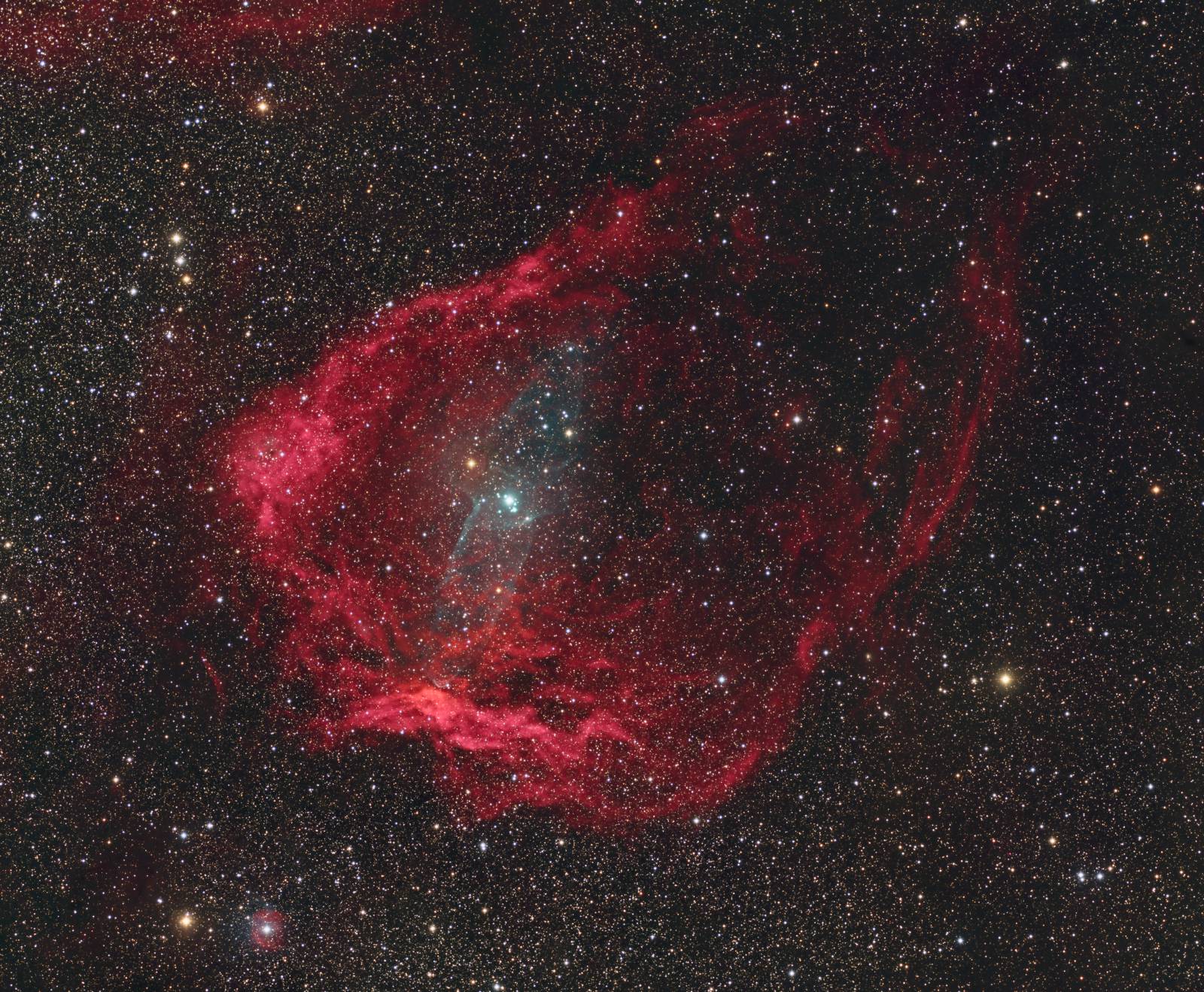Flying Bat Nebula and Squid Nebula
 Click image for full size version
Click image for full size version
October 28, 2017
This image shows the Flying Bat Nebula (Sh2-129) and the Squid Nebula (Ou 4). The Squid is a recent discovery, being first observed in 2011 by French astronomer Nicolas Outters. The Squid is thought to lie within Sh2-129 about 2,300 light years away, which makes the Squid about 50 light years in length. The combined emission and reflection nebula near bottom left is LBN 446.
The colours of emission nebulae are due to the gas they are made of being excited by energy from a star. Red comes mainly from hydrogen atoms. The teal colour of the Squid comes from atoms of oxygen. Both are excited by the bright star (actually a triple star system) near the centre of the Squid.
This is my longest exposure to date, with 104 hr acquired over 3.5 months. This was necessary to bring out the extremely faint Squid from my less than perfect skies.
Tekkies:
Moravian G3-16200 EC camera (on loan from O’Telescope), Optolong Ha, O3, R, G and B filters, Takahashi FSQ-106 ED IV at f/3.6, Paramount MX, unguided. Acquisition with the SkyX, focused with FocusMax. All pre-processing and processing in PixInsight. Acquired from my SkyShed in Guelph. Gibbous to full moon for Ha, new to crescent moon for O3 and RGB. Average or better transparency and poor to above average seeing. Acquired July 3 – October 15, 2017.
74x5m R, G and B, 279×10 Ha and 236x10m O3 unbinned frames (total=104hr).
NB-RGB Processing
Creation and cleanup: The BatchPreProcessing script was used to perform calibration, cosmetic correction and registration of all frames. DrizzleIntegration was used to make the channel masters. The R, G, B, Ha and O3 masters were cropped to remove edge artifacts and DynamicBackgroundExtraction was applied to each. R, G and B were combined to make an RGB image which was processed with BackgroundNeutralization and ColorCalibration.
O3 halo removal: The O3 channel was processed using my method to reduce halos around bright stars. A noise-weighted blend of the Green and Blue channels was used in this process.
Combining Ha, O3 and RGB data: The NBRGBCombination script was run three times to make three images:
– HaRGB1: default settings using the RGB image for broadband and Ha for red narrowband
– HaRGB2: HaRGB1 for broadband, and Ha for blue (0.01)
– HaO3RGB: default settings using RGB image for broadband, Ha for red narrowband and O3 for green and blue narrowband
HaRGB1 and HaRGB2 were blended 60:40 to give a natural colour to the red emission nebulae. The portion of the HaO3RGB image containing the Squid nebula was blended in to the HaRGB using a mask to protect all other regions of the image. PhotometricColorCalibration was applied.
Linear Noise Reduction: MultiscaleLinearTransform was used to reduce noise in the NB-RGB image. Layer settings for threshold and strength: Layer 1: 4.0, 0.92 Layer 2: 3, 0.65 Layer 3: 2, 0.43 Layer 4: 1.0, 0.25 Layer 5: 0.5, 0.14. A linear mask was used (amplification 80; smoothness 0.6).
Stretching: HistogramTransformation was applied to the NB-RGB image to make a pleasing, bright image.
Luminance Processing
Immediately prior to linear noise reduction, RGBWorkingSpace was applied to the NB-RGB image with all channel weights set to 1. The Luminance was extracted and processed separately as follows:
Deconvolution: A star mask was made to use as a local deringing support image. A copy of the image was stretched to use as a range mask, limiting deconvolution to the brightest regions of the image. Deconvolution was applied (50 iterations, regularized Richardson-Lucy, external PSF made using DynamicPSF tool with 30 stars).
Linear Noise Reduction: MultiscaleLinearTransform was used to reduce noise in the background areas. Layer settings for threshold and strength: Layer 1: 3, 0.74 Layer 2: 2, 0.52 Layer 3: 1.5, 0.25 Layer 4: 1.0, 0.11. A linear mask was used (amplification 130; smoothness 0.5).
Stretching: HistogramTransformation was applied to the Luminance to make a pleasing, bright image.
Noise Reduction and Re-Stretch: TGVDenoise was applied in Lab mode with 300 iterations with a range mask used to protect high signal areas. This was followed by a HistogramTransformation to raise the black point (but with no clipping).
Combining Luminance with NB-RGB:
The Luminance was applied to the NB-RGB image using LRGBCombine.
Additional Processing
Contrast Enhancement: HDRMultiscaleTransform was applied to a copy of the image in Median mode (6 iterations) using a mask to protect stars and background. LocalHistogramEqualization was applied twice to the same regions to restore contrast (scales of 50 and 150, maximum contrast of 1.5, strength 0.25).
Final Steps: MultiscaleLinearTransform was used to sharpen the structures in the bright parts of the nebulae (layers 2-3 at 0.05). Background, nebula and star brightness, contrast and saturation were adjusted in several iterations using Curves with masks as required. MorpohologicalTransformation was used in Morphological Selection mode (structure 3×3, selection 0.17, strength 0.3) to slightly reduce the medium sized stars. The image was downsampled by a factor of 2 to the original camera resolution to keep file size manageable for web display.
Image scale is about 3.2 arcsec per pixel for this camera / telescope combination.






Another excellent image!
What an amazing image! Spectacular work Ron.